Analysis of the 2006-07 Budget BillLegislative Analyst's Office
|
The state budget continues to benefit from healthy revenue growth. After climbing by over 8 percent in 2004-05, the 2006-07 Governor’s Budget assumes that revenues from the state’s major taxes will increase further by 6.2 percent in 2005-06 and 5.7 percent in 2006-07. As indicated in Figure 1, the administration’s current forecast is up substantially from the estimates included in the 2005-06 Budget Act. It is also up significantly from our office’s prior forecast presented in November 2005.

While the continued revenue strength is clearly positive news, we note that most of the growth is coming from volatile sources such as business earnings and investment income, which would subside quickly should the state experience a more severe slowing than is currently anticipated. In this Part, we provide background information relating to the revenue outlook, discuss recent revenue developments, summarize the budget’s revenue projections, and present our own revenue forecast.
The 2006-07 Governor’s Budget projects that California state government will receive $117 billion in revenues in 2006-07. These revenues are deposited into either the General Fund or a variety of special funds. Figure 2 shows that:
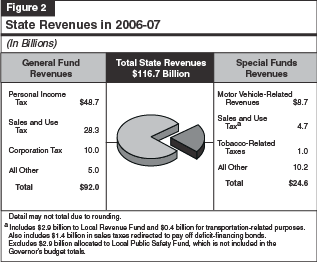
General Fund Revenues. About 79 percent of total state revenues are deposited into the General Fund. These revenues are then allocated through the annual budget process for such programs as education, health, social services, and criminal justice.
Special Funds Revenues. The remaining 21 percent of revenues are received by special funds and are primarily earmarked for specific purposes, such as transportation, local governments, and targeted health and social services programs.
As the figure shows, some revenues, such as sales and use taxes, support both the General Fund and special funds.
Sources of General Fund Revenues. Figure 2 indicates that about 95 percent of total General Fund receipts are attributable to the state’s “big three” taxes-the personal income tax (PIT), the sales and use tax (SUT), and the corporation tax (CT). The remainder is related to a variety of smaller taxes (including insurance, tobacco, and alcoholic beverage taxes), fees, investment earnings, and various transfers from special funds.
The proposed budget does not include any major tax proposals, although there are a number of limited measures that have an effect on revenues. The adoption of these various measures-which would affect PIT, SUT, and cigarette tax-would result in a net increase in revenues for 2006-07 of slightly over $250 million.
As shown in Figure 3, the largest of the proposals continues the suspension of the Teacher Tax Credit for the 2006 tax year. This PIT credit is available to credentialed teachers and ranges from $150 to $1,500 per claimant depending upon years of experience. The continued suspension of the credit would result in a net increase in PIT revenues of $210 million in the budget year. This program was adopted in 2000, but was suspended for tax years 2002, 2004, and 2005. Also, the administration proposes conforming the state PIT to federal law regarding Health Savings Accounts for individuals, and making these accounts more flexible. This would result in a revenue reduction of $3 million in the current year and $8 million in the budget year.
|
|
|||
|
Figure 3 2006-07 General Fund Revenue Changes |
|||
|
(In Millions) |
|||
|
|
Fiscal Impact |
||
|
|
2005-06 |
2006-07 |
2007-08 |
|
Personal Income Tax |
|
|
|
|
Teacher tax credit: suspend for an additional year |
— |
$210 |
— |
|
Health Savings Accounts: conform to federal law |
-$3 |
-8 |
-$15 |
|
Sales and Use Tax |
|
|
|
|
Vehicle, vessel, and aircraft use
tax: |
— |
$35 |
— |
|
Compliance measuresa |
— |
14 |
$13 |
|
Cigarette Tax |
|
|
|
|
Compliance measuresa |
— |
$1 |
$1 |
|
Totals, 2006-07 Revenue Measures |
-$3 |
$252 |
-$1 |
|
|
|||
|
a There also are additional special funds revenue gains of $30 million in 2006-07 and $15 million in 2007-08. |
|||
|
|
|||
An additional policy change involving the application of SUT to the out-of-state purchase of vehicles, vessels, and aircraft would result in revenues of $35 million in the budget year. Legislation passed along with the 2004-05 Budget Act increased the period of time that such purchases have to be kept out of state in order to avoid the payment of SUT from 90 days to one year. This provision is scheduled to sunset July 1, 2006 (at which point the period returns to 90 days); the Governor’s proposal would extend the sunset date to July 1, 2007.
Finally, the administration proposes a number of collection efforts involving SUT that are intended to help address the state‘s tax gap. These proposals, which are reviewed in the General Government section of our Analysis of the 2006-07 Budget Bill, consist of (1) additional collections based on agricultural inspection station information, (2) expanded licensing of retailers, and (3) enhanced enforcement of Internet and mail order sales of cigarettes. This last measure would also have an impact on increasing cigarette excise taxes.
The Governor’s budget reflects a major improvement in the revenue outlook. It assumes that revenues during 2004-05 and 2005-06 will be up by a combined total of over $5.4 billion relative to the estimates contained in the 2005-06 Budget Act. The budget’s revenue projections are summarized in Figure 4.
|
|
||||||
|
Figure 4 Summary of the Budget’s |
||||||
|
(Dollars in Millions) |
||||||
|
|
|
2005-06 |
|
2006-07 |
||
|
|
Actual 2004-05 |
Estimated Amount |
Percent Change |
|
Projected Amount |
Percent Change |
|
Taxes |
|
|
|
|
|
|
|
Personal income |
$42,738 |
$45,493 |
6.4% |
|
$48,716 |
7.1% |
|
Sales and use |
25,759 |
27,184 |
5.5 |
|
28,295 |
4.1 |
|
Corporation |
8,670 |
9,621 |
11.0 |
|
10,024 |
4.2 |
|
Insurance |
2,233 |
2,246 |
0.6 |
|
2,340 |
4.2 |
|
Other |
671 |
456 |
-32.0 |
|
459 |
0.5 |
|
Other Revenues, Transfers, and Loans |
|
|
|
|
||
|
Other revenues |
$1,904 |
$2,705 |
42.1% |
|
$2,144 |
-20.7% |
|
Transfers |
235 |
-14 |
— |
|
27 |
— |
|
Totals |
$82,209 |
$87,691 |
6.7% |
|
$92,005 |
4.9% |
|
|
||||||
2004-05 Actual. The budget shows that 2004-05 General Fund revenues and transfers totaled $82.2 billion, a 6.9 percent increase from 2003-04. The administration’s estimate is up $2.3 billion from the level assumed when the 2005-06 budget was enacted. This is an unusually large prior-year revision. It includes a $1 billion increase in CT revenues, a $700 million increase in PIT revenues, and over $500 million from SUT.
The prior-year increase is related to stronger cash collections and lower refunds occurring during the current year that are attributable to prior-year tax liabilities. Under California’s accrual method of accounting, these payments and refunds are accrued back to 2004-05. The transactions are mainly related to audit assessments and taxes owed on PIT and CT extension returns that were filed in the second half of calendar 2005.
2005-06 Estimate. The administration’s forecast assumes that General Fund revenues and transfers will be $87.7 billion, a 6.7 percent increase from the prior year. This revised estimate is up $3.2 billion from the revenue forecast contained in the 2005-06 Budget Act. Of this total, about $2.2 billion is related to PIT, $800 million is related to CT, and $200 million is from SUT. In all three cases, the main factor behind the upward revisions is stronger-than-expected payments associated with tax liabilities in 2005.
2006-07 Forecast. The budget forecasts that General Fund revenues and transfers will be $92 billion in the budget year, a 4.9 percent increase from 2005-06. The relatively low growth rate reflects a decline in nontax revenues in 2006-07. Adjusting for one-time factors (such as proceeds from the refinancing of a tobacco bond in the current year), the underlying growth rate is higher-about 5.6 percent-or about the same pace as the projected growth in the state’s economy.
Figure 5 shows our projections of General Fund revenues for 2005-06 through 2007-08. These projections are based on our economic and demographic forecasts presented in Part II of this volume and reflect the impacts of the Governor’s revenue-related policy proposals. For the current year and budget year combined, our revised estimates are higher than the administration’s by roughly $2.3 billion.
|
|
||||||
|
Figure 5 Summary of the LAO’s General Fund Revenue Forecast |
||||||
|
(Dollars in Millions) |
||||||
|
|
Estimated |
Projected |
Projected |
|||
|
|
|
Percent Change |
|
Percent |
|
Percent |
|
Taxes |
|
|
|
|
|
|
|
Personal income |
$46,490 |
8.8% |
$49,480 |
6.4% |
$52,360 |
5.8% |
|
Sales and use |
27,210 |
5.6 |
28,410 |
4.4 |
29,890 |
5.2 |
|
Corporation |
9,800 |
13.0 |
10,170 |
3.8 |
10,610 |
4.3 |
|
Insurance |
2,250 |
0.8 |
2,363 |
5.0 |
2,433 |
3.0 |
|
Other |
456 |
-31.9 |
454 |
-0.5 |
459 |
1.1 |
|
Other Revenues, Transfers, and Loans |
||||||
|
Other revenues |
$2,779 |
45.9% |
$2,129 |
-23.4% |
$2,230 |
4.7% |
|
Transfers |
-14 |
— |
27 |
— |
28 |
1.9 |
|
Totals |
$88,971 |
8.2% |
$93,033 |
4.6% |
$98,010 |
5.4% |
|
|
||||||
The main reason for our higher revenue estimates is our assessment of recent very strong cash payment trends. As indicated in Figure 6, quarterly estimated payments from individuals and corporations rose by about 25 percent during 2005, reflecting strong growth in business earnings and (in the case of PIT payments) healthy gains in investment income. Personal income tax withholding, though less robust, nevertheless was up by a solid 8 percent during the year. These positive cash trends suggest that final payments on 2005 tax liabilities will be stronger than assumed in the Governor’s budget forecast. Absent an abrupt downturn in the economy, the higher levels of CT and PIT liabilities in 2005 will have positive implications for the 2006-07 outlook as well.
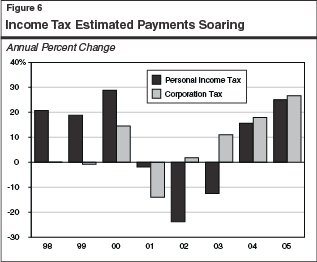
Based on these recent strong growth trends, we project that General Fund revenues will exceed the administration’s forecast in both the current and budget years. We specifically forecast that:
In 2005-06, General Fund revenues and transfers will total $89 billion, an 8.2 percent increase from 2004-05. This is up $1.3 billion from the budget forecast, reflecting a $1 billion increase in PIT, and more modest gains from the other major revenue sources.
In 2006-07, revenues and transfers will total $93 billion, a 4.6 percent increase. This projected growth rate is affected by one-time factors, such as the current-year refinancing of tobacco bonds. After adjusting for these effects, the underlying grow in revenues is about 5.2 percent, or slightly less than personal income. Our forecast is up $1 billion from the budget projection, reflecting gains from each of the three major taxes.
In 2007-08, revenues and transfers will total $98 billion, an increase of 5.4 percent. Excluding the impact of temporary revenue measures set to expire in that year (such as a suspension of the teachers’ credit), the underlying growth rate of major tax revenues is about 5.6 percent, or about the same as the projected growth in statewide personal income during the period.
While the current revenue strength is welcome, it is important to remember that it is coming mainly from soaring profits and investment earnings, which are highly sensitive to changes in the economy. This is an important consideration, given the underlying risks in the economic outlook discussed in Part II associated with energy costs and the state’s housing markets. As we indicated in that discussion, a steeper-than-expected housing slowdown could easily reduce overall economic growth relative to our baseline forecast by 1.4 percent in 2006 and 2 percent in 2007. Given the historical relationship between cyclical changes in the economy and state revenues, we estimate that a steeper slowdown of this nature in economic activity would reduce General Fund revenues from our baseline forecast by more than $4 billion in 2006-07.
As indicated above, the great majority of General Fund revenues are attributable to the state’s three major taxes-PIT, SUT, and CT. The performance of these taxes will have a major influence on the overall revenue outlook. In the following sections, we discuss in more detail recent developments and the outlook for each of these key revenue sources.
The PIT is, by far, the state’s largest revenue source, accounting for 53 percent of total General Fund revenues in 2006-07. In general, PIT is patterned after federal law with respect to reportable types of income, deductions, exemptions, exclusions, and credits. Under PIT, taxable income is subject to marginal rates ranging from 1 percent to 9.3 percent, with the top rate applying to taxable income in excess of about $83,000 for joint returns in 2006 (and one-half of that for taxpayers filing single returns). Beginning in 2005, a 1 percentage surcharge was imposed on incomes in excess of $1 million (for a total marginal rate of 10.3 percent for affected taxpayers). The proceeds of this surcharge, which was implemented following approval of Proposition 63, are allocated to a special fund to support various mental health programs.
Overall, nearly 75 percent of adjusted gross income (AGI) declared on tax returns is attributable to ordinary wages and salaries of workers. However, the other 25 percent of AGI-consisting primarily of business earnings, capital gains, stock options, and other forms of investment income-has a disproportionate effect on year-to-year changes in PIT liabilities. This is so for two main reasons:
First, nonwage income accrues mainly to taxpayers at the top end of the income spectrum, and thus is taxed at higher marginal rates than most other income. For example, over 90 percent of stock options, capital gains, and business income-which combined account for the majority of nonwage income-accrue to the top 5 percent of taxpayers (those with incomes in excess of $160,000 in 2003, the most recent year for which such data are available).
Second, nonwage income is volatile. It rises much faster than ordinary wages in good times and falls much further in bad times. This is illustrated in Figure 7, which compares year-to-year changes in ordinary wages (that is, wages excluding stock options) and nonwage income during the past 16 years. While the extreme income changes in the late 1990s and early 2000s were the result of unprecedented swings in capital gains and stock options, the greater volatility in nonwage income sources has been present throughout the period.
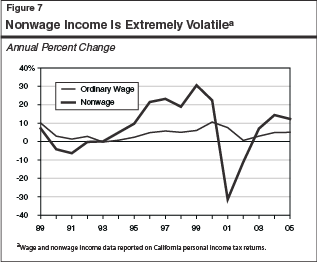
In recent years, PIT revenues have benefited from the boom in nonwage income. Between 2003 and 2005, for example, growth in these sources was responsible for much of the 35 percent growth in overall PIT liabilities. Looking ahead, we expect nonwage income sources to continue to expand, but at a much slower pace. Specifically, our forecast assumes that:
Business earnings growth will slow from 15 percent in 2005 to slightly less than 5 percent per year in 2006 and 2007. The anticipated slowdown reflects more modest increases in profits generally, and significant declines in earnings related to real estate construction, sales, and financing over the next two years.
Capital gains and stock-option-related income growth will slow from 10 percent in 2005 to just 5 percent in both 2006 and 2007. Our forecast assumes that slowing corporate profit growth coupled with rising interest rates will hold down stock price appreciation, and that a slowdown in the housing market will result in modest declines in capital gains related to real estate sales.
The assumption that these PIT-related income sources will continue to expand, albeit at a modest pace, is crucial to the overall revenue outlook. Declines in these volatile sources next year would significantly depress PIT liabilities relative to our forecast in 2006 and 2007.
We expect ordinary wages (that is, wages excluding stock-option income) to grow at a steady pace of around 5 percent annually for the next two years, reflecting modest gains in employment and compensation rates during the period.
Based on our estimated changes in PIT liabilities, we forecast that fiscal-year PIT receipts will total $46.5 billion in 2005-06, $49.5 billion in 2006-07, and $52.4 billion in 2007-08. Our revenue estimates also take into account amnesty-related revenue effects on audit collections (discussed in accompanying box) as well as the Governor’s proposal to extend the suspension of the teachers’ credit for an additional year. Compared to the budget forecast, our current projection of PIT revenues is up by $1 billion in the current year, and by about $760 million in 2006-07.
Revenue Impact of Tax AmnestyIn addition to the basic economic factors (such as profits and personal income) that affect revenues from the personal income tax (PIT) and the corporation tax (CT), another factor that is currently having significant revenue impacts on both taxes involves the cash-flow effects of the state’s recent tax amnesty program. Large Cash In-Flow Initially Occurred. The tax amnesty program ran for part of 2004-05 from February 1, 2005 to March 31, 2005. Although the net revenue gain from amnesty is ultimately expected to be relatively modest once all cash-flow shifts over time are accounted for-about $380 million-the amnesty program resulted in an increase in General Fund cash receipts totaling $3.8 billion in 2004-05. Under California’s system of accrual accounting, these receipts were reflected as a $3.8 billion upward adjustment to the state’s carry-in balance for the 2004-05 fiscal year. Nature of the Amnesty Payments. About one-fifth of the amnesty-related payments received was attributable to the program’s voluntary participants, while the remaining four-fifths was attributable to companies that chose not to participate in the amnesty program but still chose to file so-called “protective claim” payments. These are payments made by these taxpayers to avoid the possibility of being charged high post-amnesty penalties if their outstanding tax challenges are not ultimately upheld, or if they receive future audit assessments related to past tax years. Most Payments Represent Accelerations. The majority of the payments received are expected to be offset by lower net collections in the future. The 2005-06 Budget Act revenue forecast assumed that all but $380 million of the $3.8 billion cash gain represented either tax payments that will eventually be refunded (which will occur in those cases where the taxpayers prevail in their audit disputes), or accelerations of collections that would have otherwise been received in future years through the normal audit process. It was specifically assumed in the 2005-06 Budget Act that these refunds and accelerations would reduce net PIT and CT cash collections by $1.5 billion in 2005-06, $1 billion in 2006-07, and $900 million in 2007-08. However, under the state’s accrual accounting system, these annual reductions would be accrued back to the respective preceding years. As a result, all of the amnesty-related offsets were expected to occur in the 2004-05 through 2006-07 fiscal years (see accompanying figure). Based on audit trends evident this fall, both our office and the administration modified the timing of the future revenue reductions, spreading out the offsets over a larger number of years. However, both our November forecast and the 2006-07 Governor‘s Budget continued to assume that the ultimate net gain from the amnesty program would be $380 million. Faster-Than-Expected Amnesty Processing Also to Generate Benefits. Our updated estimated net revenue gain from those filing amnesty and protective claims payments is still $380 million. However, based on updated audit workload information from the Franchise Tax Board (FTB), we are now assuming that there will be an additional $400 million in revenues from 2006-07 through 2011-12 indirectly associated with amnesty. This is because FTB indicates that the filing of protective claims is resulting in faster and less costly resolution of the audit cases than it had estimated previously. This, in turn, is expected to “free up” audit staff once the protective claims related audits are completed by 2006-07, to undertake other revenue-producing activities in 2006-07 through 2008-09. It remains the case, however, that all of these amnesty-related estimates are subject to future revision as FTB closes out more cases involving protective claims payments. |
The SUT is the General Fund’s second largest revenue source, accounting for just under one-third of total revenues in 2005-06. The main SUT component is the sales tax, which is imposed on retail sales of tangible goods sold in California. Some examples of sales tax transactions include spending on clothing, furniture, computers, electronics, appliances, automobiles, and motor vehicle fuel. Purchases of building materials that go into the construction of homes and buildings are also subject to the sales tax, as are purchases of computers and other equipment used by businesses. Roughly 70 percent of SUT is remitted by retailers, while the remaining 30 percent is directly paid by businesses who themselves consume or use the products being taxed. The largest exemption from the sales tax is for most food items consumed at home. The great majority of services are not subject to the sales tax.
The second component of SUT-the use tax-is imposed on products bought from out-of-state firms by California residents and businesses for use in this state. With the exception of automobile purchases, vessels, and aircraft (which must be registered), out-of-state purchases are difficult to monitor, and the state is prohibited under current federal law from requiring most out-of-state sellers to collect the use tax for California. As a result, use tax receipts account for only a small portion of total SUT revenues.
The total SUT rate levied in California is a combination of several different individual rates imposed by the state and various local governments. These include:
State Rate. The basic state SUT rate is 6 percent. The largest single component is the 5 percent state General Fund rate. Also included in the overall state rate are two half-cent rates whose proceeds are deposited into (1) the Local Revenue Fund, which supports health and social services program costs associated with the 1991 state-local realignment legislation, and (2) the Local Public Safety Fund, which was approved by the voters in 1993 for the support of local criminal justice activities.
Uniform Local Rate. This is a uniform local tax rate of 1.25 percent levied by all counties (the so-called Bradley-Burns rate). Of this total, 0.25 percent is deposited into county transportation funds, while the remaining 1 percent is allocated to city and county governments for their general purposes. Under the terms of Proposition 57, which was approved by the voters in March 2004, 0.25 percent of the Bradley-Burns rate is diverted to a special fund for purposes of repayment of the deficit-financing bonds that were issued in 2004 to help deal with the state’s budget problem. (These diverted local sales taxes are currently replaced by a shift of property taxes from schools, which are in turn reimbursed by Proposition 98 payments to schools by the state General Fund. As a result of these various steps, state government is ultimately responsible for the bonds’ repayment.) The diversion of sales tax revenues will remain in effect until the bonds are paid off.
Optional Local Rates. The final overall SUT rate component involves optional local tax rates, which local governments are authorized to levy for any purpose. These taxes, which require local voter approval, are normally levied on a countywide basis-primarily for transportation-related purposes. They are generally levied in 0.25 percent or 0.5 percent increments and cannot exceed 1.5 percent in total (except in San Francisco and San Mateo Counties).
Combined SUT Rates Throughout California. The combined state and local SUT rate varies significantly across California geographically due to differences in the local optional rates that are levied (see Figure 8). The combined SUT rate currently ranges from 7.25 percent (for those counties with no optional rates) up to 8.75 percent (for Alameda County and the City of Avalon in Los Angeles County).
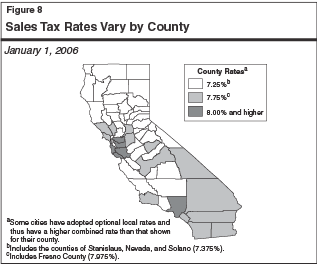
Taxable sales jumped by 8.7 percent in 2004, the second largest gain in the past two decades. The overall increase reflected balanced growth in transactions related to consumer retail spending, business investment, and home construction. Detailed taxable sales data for 2005 are not yet available. However based on preliminary information, it appears that taxable sales expanded at a more moderate pace of around 6.5 percent in 2005. This increase appears to be related to less-robust, but still healthy, growth in consumer and construction-related spending last year. The jump in gasoline prices likely resulted in dramatic increases in taxable sales. However, these increases were likely offset, to some extent, by reduced spending on other areas, such as in automotive sales.
As indicated in Figure 9, we forecast that taxable sales growth will ease to 5.3 percent in 2006 and 5.4 percent in 2007. Most areas of taxable spending are expected to slow. Specifically, the forecast assumes:
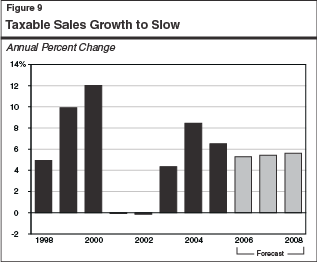
A reduced level of home sales and construction activity, which implies less taxable spending on building materials and home furnishings.
Some tapering in consumer spending on other commodities, due to high debt levels and rising interest rates.
Continued solid gains in business-related sales, as companies maintain a high level of investment activity.
Based on our forecast of taxable sales, we project that SUT receipts will total $27.2 billion in 2005-06, $28.4 billion in 2006-07, and $29.9 billion in 2007-08. Compared to the budget forecast, our SUT revenue estimate is up just $26 million in 2005-06 and by $115 million in 2006-07.
The CT is the third largest state revenue source, accounting for 11 percent of total revenues in 2004-05. The tax is levied at a general rate of 8.84 percent on California taxable profits. Banks and other financial institutions subject to CT pay an additional 2 percent tax, which is in lieu of most other state and local levies. Corporations that qualify for California Subchapter “S” status are subject to a reduced 1.5 percent corporate rate. In exchange, the income and losses from these corporations are “passed through” to their shareholders where they are subject to PIT. Similarly, businesses that are classified as Limited Liability Companies pay a fee at the corporate level and their income and losses are passed through to their shareholders, where they are subject to PIT.
Approximately two-thirds of all CT revenues come from multistate and multinational corporations. These companies have their consolidated U.S. income apportioned to California based on a formula involving the share of their combined property, payroll, and sales that is attributable to this state.
California’s CT allows for a variety of exclusions, exemptions, deductions, and credits, many of which are similar or identical to those provided under the federal corporate profits tax. Key examples include the research and development tax credit and net operating loss carryforward provisions, whereby companies can use operating losses incurred in one year as a deduction against earnings in subsequent years. Under legislation enacted in 2002, corporations were not able to use these losses to offset their income in tax years 2002 and 2003. However, such deductions were allowed again beginning in 2004, and the percentage of losses which may be carried forward and deducted against future tax liabilities jumped from 65 percent under prior law to 100 percent beginning for losses incurred starting in 2004.
After many years of near-stagnant growth, revenue collections from CT have soared in recent years (see Figure 10). These increases, which have coincided with strong increases in collections experienced in other states and also at the federal level, reflect major increases in reported taxable profits and a recent increase in audit collections.
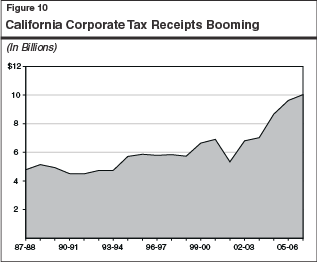
The key determinant of CT receipts is the strength of corporate profits reported on California tax returns by businesses. These profits have grown at a dramatic pace during the past two years, up by 20 percent in 2004 and a further 22 percent in 2005. Based on CT payments information from the Franchise Tax Board (FTB), it appears that most major industries experienced significant growth during 2005, with businesses in the construction, finance, energy, and utility industries experiencing particularly large gains. Factors underlying strong profit growth include solid growth in sales, modest increases in compensation, and continued strong rates of productivity growth.
Looking ahead, we forecast that taxable California corporate profit growth will slow significantly to around 6 percent in 2006 and just 4 percent in 2007. This anticipated slowdown is partly related to projected declines in real estate activities and their related financial earnings. It also reflects more-moderate profit growth in other industries, reflecting a reduced pace of expansion in sales and output in the overall economy.
In addition to strong profit growth, a second factor that has contributed to CT revenue increase is a large increase in audit collections. The year-to-year pattern of these collections is being distorted by the cash-flow effects of the amnesty program (see "Revenue Impact of Tax Amnesty" section earlier in this writeup). However, after adjusting for these effects, the “baseline” level of audit collections appears to have doubled in the past five years, rising from $600 million in 2000-01 to $1.2 billion in 2005-06. (We note PIT-related audit collections have also increased, although at a less dramatic pace.) The recent increase has been greater than expected, adding $250 million per year to our estimated revenue totals from 2004-05 through 2006-07.
Reasons for Recent Increases. The FTB indicates that these recent increases are related to audit assessments associated with business activity in the late 1990s and early 2000s. During this period, there was significant growth in income sheltering and use of abusive tax shelters.
We forecast that CT receipts will be $9.8 billion in 2005-06, a 13 percent increase from the prior year. Thereafter, we forecast that collections will expand more modestly, by 3.8 percent (to $10.2 billion) in 2007-08 and 4.3 percent (to $10.6 billion) in 2007-08. Our estimates take into account the projected increases in business profits, as well as the factors affecting audit collections. Our CT revenue forecast is above the budget estimate by $179 million for the current year and $146 million for the budget year.
The remaining 5 percent of total 2005-06 General Fund revenues and transfers consists primarily of taxes on insurance premiums, alcoholic beverages, and tobacco products. It also includes interest income and a large number of fees, loans, and transfers. We forecast that combined revenues from all of these other sources will fall from $5.5 billion in 2005-06 to $5 billion in 2006-07, and then rise to $5.2 billion in 2007-08. The current-year total includes $525 million in one-time funds related to the refinancing of a previously issued tobacco securitization bond. The projection for 2006-07 reflects lower receipts from state tidelands oil revenues and abandoned property, moderate increases in insurance and alcohol-related taxes, and slight declines in cigarette tax receipts.
Special funds revenues are related to a variety of sources:
About $8.7 billion (or one-third of the budget-year total) is related to motor vehicle revenues. These include the vehicle license fee, which is assessed in lieu of the property tax and whose proceeds are distributed to local governments, mostly for their general purposes. They also include fuel taxes and registration fees, which support transportation-related spending.
Another $4.7 billion is related to SUT. Of this total, about $2.9 billion is used to fund health and social services programs that were realigned from the state to local governments beginning in the early 1990s, $1.4 billion is related to the diversion of local sales taxes for deficit-financing bond debt service, and about $442 million is used for transportation programs.
About $978 million is from tobacco taxes that have been approved by voters in various elections.
Roughly $690 million is related to the high-income PIT surcharge for mental health programs, which was approved by voters as Proposition 63 in November 2004.
The remaining special funds revenues are related to a wide variety of sources, including an energy resource surcharge, beverage container redemption fees, and California State University fees.
As shown in Figure 11, the Governor’s budget assumes that special funds revenues will total $24.5 billion in the current year (a 10 percent increase) and $24.6 billion in 2006-07 (a 0.6 percent increase). The current-year total reflects one-time proceeds from the assumed sale of a $1 billion tribal gaming bond, the proceeds of which would be used for transportation purposes. Because of court challenges, the administration has indicated that the sale will be delayed until at least 2006-07. Excluding these bond proceeds and other one-time factors, special funds revenues from ongoing sources are projected to increase by roughly 4 percent in both 2005-06 and 2006-07, reflecting modest increases in sales taxes, vehicle license fees, and tobacco-related taxes.
|
|
||||||||
|
Figure 11 Summary of the Budget’s |
||||||||
|
(Dollars in Millions) |
||||||||
|
|
|
2005‑06 |
|
2006‑07 |
||||
|
|
Actual 2004‑05 |
Estimated Amount |
Percent Change |
|
Projected Amount |
Percent |
||
|
Motor Vehicle Revenues |
|
|
|
|
|
|||
|
License fees (in lieu) |
$2,136 |
$2,221 |
4.0% |
|
$2,308 |
3.9% |
||
|
Fuel taxes |
3,366 |
3,398 |
0.9 |
|
3,483 |
2.5 |
||
|
Registration, weight, and miscellaneous fees |
2,716 |
2,847 |
4.8 |
|
2,935 |
3.1 |
||
|
Subtotals |
($8,218) |
($8,467) |
(3.0%) |
|
($8,725) |
(3.1%) |
||
|
Sales and Use Tax |
|
|
|
|
|
|
||
|
Realignment |
$2,625 |
$2,758 |
5.1% |
|
$2,862 |
3.8% |
||
|
Deficit-financing bonds |
1,163 |
1,378 |
18.5 |
|
1,415 |
2.7 |
||
|
PTAa |
420 |
329 |
-21.8 |
|
442 |
34.5 |
||
|
Subtotals |
($4,209) |
($4,464) |
(6.1%) |
|
($4,719) |
(5.7%) |
||
|
Other Sources |
|
|
|
|
|
|
||
|
Personal income tax |
$254 |
$683 |
168.9% |
|
$690 |
1.0% |
||
|
Cigarette and tobacco taxes |
977 |
948 |
-3.0 |
|
978 |
3.2 |
||
|
Interest earnings |
126 |
109 |
-13.9 |
|
109 |
0.5 |
||
|
Other revenues |
8,712 |
9,875 |
13.4 |
|
9,038 |
-8.5 |
||
|
Transfers and loans |
-244 |
-67 |
-72.5 |
|
358 |
— |
||
|
Totals |
$22,252 |
$24,479 |
10.0% |
|
$24,618 |
0.6% |
||
|
|
||||||||
|
a Public Transportation Account. |
||||||||
|
Detail may not total due to rounding. |
||||||||
|
|
||||||||